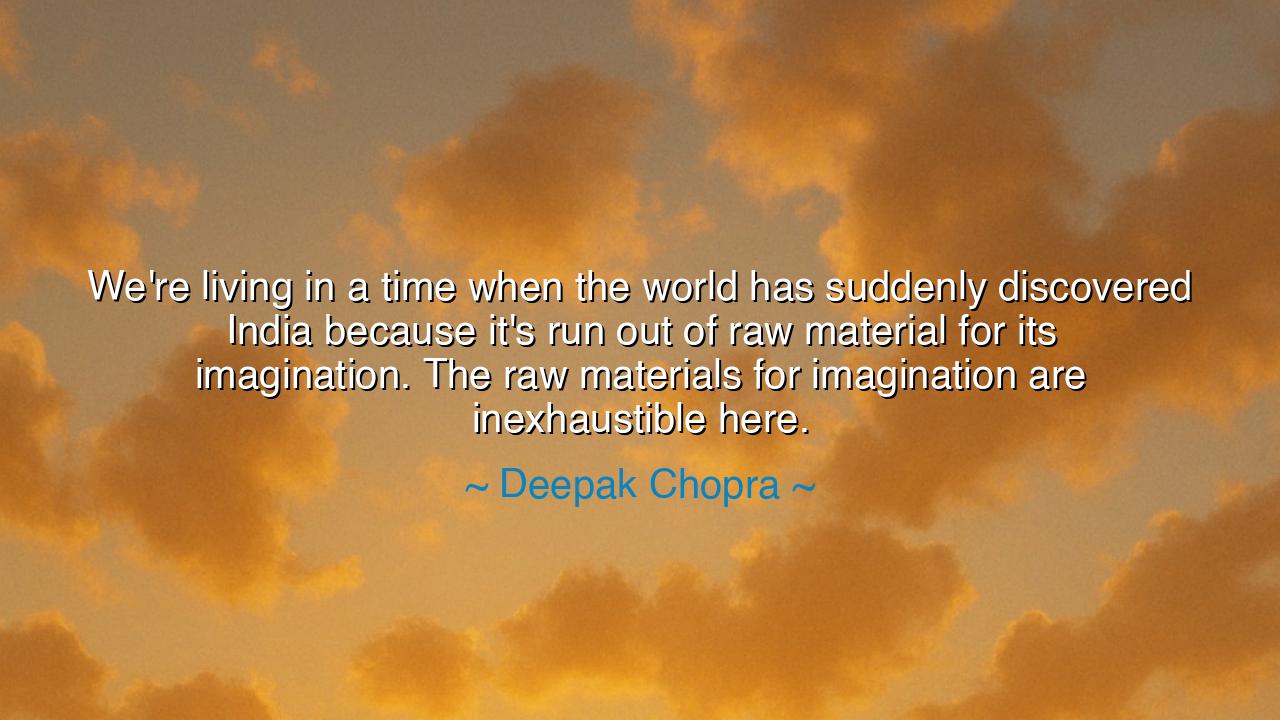
We're living in a time when the world has suddenly discovered
We're living in a time when the world has suddenly discovered India because it's run out of raw material for its imagination. The raw materials for imagination are inexhaustible here.






The Eternal Source: On Imagination and the Spirit of India
Hear, O listener of truth, the words of Deepak Chopra, the modern sage who bridges the worlds of science and spirit: “We’re living in a time when the world has suddenly discovered India because it’s run out of raw material for its imagination. The raw materials for imagination are inexhaustible here.” These words are both a revelation and a reminder — that the wellspring of imagination is not found in the fleeting inventions of industry or the machinery of modernity, but in the eternal depths of the human spirit. And India, in its vastness of soul, has long been the sacred field where such imagination has flourished without end.
In this saying, Chopra speaks not merely of a place, but of a state of consciousness. He does not mean that the world has discovered a geographical land, but that it has turned its gaze inward — toward the ancient soil of wisdom, story, and dream that India embodies. The imagination of the modern world, burdened by materialism, has begun to exhaust itself. It has explored the physical universe, mapped the seas, charted the stars, yet has grown blind to the inner universe of meaning. And so, in its hunger for renewal, it turns to India — the cradle of philosophies that teach that creation begins not in the hand, but in the mind; not in matter, but in spirit.
For millennia, India has been the temple of imaginative vision. Here were born not only religions, but realms of thought that saw the divine in the smallest seed and the infinite in the human heart. The Upanishads dreamed of worlds unseen; the Mahabharata and Ramayana wove human struggle and cosmic law into one great story of existence. The poets of old — Kalidasa, Kabir, Mirabai, Tagore — did not merely describe life; they transfigured it. This is what Chopra means when he says that the “raw materials for imagination are inexhaustible” here — for the soil of India is composed not of minerals and stone, but of myth, meditation, and the yearning of the human soul for truth.
Consider the story of Rabindranath Tagore, who, amidst the chains of colonial rule, dreamed of a free nation shaped not by imitation but by imagination. He envisioned schools where children would learn beneath trees, absorbing knowledge from nature and poetry as much as from books. His song “Jana Gana Mana”, now India’s national anthem, was not merely a call to patriotism, but to awakening — a reminder that India’s true freedom lay in the imagination of its people. Through his art, he proved Chopra’s insight: that the spiritual imagination of India can never be conquered, for it springs from the eternal.
The modern world, in contrast, has grown weary. It has built towers of glass and circuits of light, but in doing so has forgotten the light within. It has grown rich in tools but poor in vision. Chopra’s words are thus both celebration and warning: that when a civilization loses its imagination, it loses its soul. For imagination is not a luxury; it is the breath of creation. Without it, technology becomes hollow, art becomes imitation, and life becomes repetition. India’s gift to the world, then, is not wealth or invention, but the reawakening of imagination as a sacred force — the reminder that the infinite resides in the heart of every being.
Yet Chopra’s teaching is not a call to nostalgia, but to renewal. The imagination he speaks of is not confined to the past; it is a living fire, ready to be kindled in every mind that dares to see beyond limits. To draw from India’s inexhaustible spring of imagination is to live in the awareness that the divine and the human are not separate, that every thought can create, every vision can heal. Whether one stands upon the banks of the Ganges or in the midst of a crowded city, the sacred imagination is ever near — if only one remembers to listen, to dream, to awaken.
So, O child of the eternal, take this lesson into your soul: Feed your imagination, for it is the bridge between the world you see and the world you can create. Let it be nourished by story, silence, and wonder. Learn from India not only to think, but to dream consciously — to see the divine in every face, the infinite in every atom. When the world’s imagination falters, let yours rise; when its vision dims, let your heart shine. For the imagination, when joined with compassion and awareness, becomes the highest act of creation — the act by which humanity renews itself.
Thus, as Deepak Chopra teaches, India’s wealth is not in her gold, nor in her monuments, but in her imagination — that endless capacity to see the unseen, to create from within, and to turn the chaos of existence into harmony. And this same wealth lies hidden in every soul that dares to dream. For imagination, like India, is inexhaustible — an eternal flame, burning quietly within the heart of humankind, waiting to be discovered again and again.






AAdministratorAdministrator
Welcome, honored guests. Please leave a comment, we will respond soon